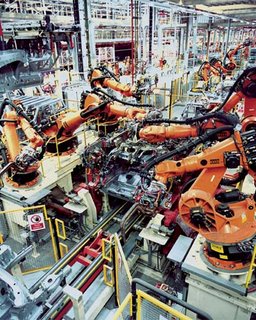Robots are utilized in many industries where the environment is hazardous or when the company wants to reduce manpower with automation. Som e examples of these industries are automobile industries, semiconductor industries, food industries, nuclear industries, power line maintenance industries and many more. This is because utilizing robots could (1) reduces health risk, (2) improve safety, (3) improve availability by allowing maintenance to take place during operations instead of halting operations, (4) access areas unreachable by human, and (5) shorten mean time to repair by reducing the response time to failures.[1]
e examples of these industries are automobile industries, semiconductor industries, food industries, nuclear industries, power line maintenance industries and many more. This is because utilizing robots could (1) reduces health risk, (2) improve safety, (3) improve availability by allowing maintenance to take place during operations instead of halting operations, (4) access areas unreachable by human, and (5) shorten mean time to repair by reducing the response time to failures.[1]
Currently, the most common type of robots in the industrial / service field is the articulated robot (robotic arm). There are various grade of robotic arms, from 2-axis – to reach any point in a plane, 3-axis – to reach any point in a space, up to 6-axis (addition of roll, pitch and yaw axis) robotic arm. The more the number of axis the robotic arm has, the more flexible is the robotic arm. A sophisticated robotic arm is capable of moving from side-to-side, up-and-down and even 360 degree which a human arm may not be able to perform.
is the articulated robot (robotic arm). There are various grade of robotic arms, from 2-axis – to reach any point in a plane, 3-axis – to reach any point in a space, up to 6-axis (addition of roll, pitch and yaw axis) robotic arm. The more the number of axis the robotic arm has, the more flexible is the robotic arm. A sophisticated robotic arm is capable of moving from side-to-side, up-and-down and even 360 degree which a human arm may not be able to perform.
Robotic arms are built to operate in high precision, high speed and heavy duty performances which again even a human arm could not achieve. Robotic arms are used in the vast number of industries, ranging from welding, painting, ironing, assembly, pick and place, product inspection, testing, material handling, packaging, palletizing and many more. Furthermore, more sophisticated industrial robots would also have artificial intelligence and video on them which are linked to powerful computers giving the robots machine visions and therefore capable of better precision guidance.
One of the applications for industrial robots is in the electronic printed circuit board (PCB) industry which uses robot arms to place very small components (Surface Mounted Devices (SMD)) on the PCB accurately precise at a very fast pace. As the component size reduces, it is difficult to use human labor for this task due to human-error such as misplace of components and accuracy of placement. The most commonly used robot arm in this industry is the popular Selective Compliant Articulated/Assembly Robot Arm (SCARA) [2], a 4-axis industrial robot as it offers best price/performance ratio as regarding speed. The SCARA is commonly used in the PCB industry because the SCARA provides an advantage for assembly operations, e.g., inserting a round pin in a round hole without binding.
The SCARA has three moving axis (X, Y and Z) and a fourth axis of motion (Theta-Z) for wrist rotation. The SCARA arm is slightly compliant in the  X-Y direction but rigid in the Z direction, Hence the term Selective Compliant and the advantage for assembly operations as mentioned above. The movement of the joints is done using motors or hydraulic actuators connected to the controller which allow programming of the various control parameters such as accelerations, velocity, deceleration, and distance of a series of coordinated motions.
X-Y direction but rigid in the Z direction, Hence the term Selective Compliant and the advantage for assembly operations as mentioned above. The movement of the joints is done using motors or hydraulic actuators connected to the controller which allow programming of the various control parameters such as accelerations, velocity, deceleration, and distance of a series of coordinated motions.
It has been more than 4 decades that robots are utilize in industries and it is gaining even more popularity due to the various benefits it can give. The most important benefit, I believe, is definitely cost savings and yet capable of achieving maximum throughput for the company that uses robots. This is because the robots could operate non-stop 24 hours a day, 7 days a week with occasional halt for maintenance. The robots utilized in the industries are becoming the driving force for future technology. It has become an indispensable component in the modern industries.
1 comment:
u0300643 Cheong Chong Kiat
Robotic arm is our new pair of handy aid that assist us in many dangerous operations. This creation do save us a lot of our precious time and safety.
Post a Comment